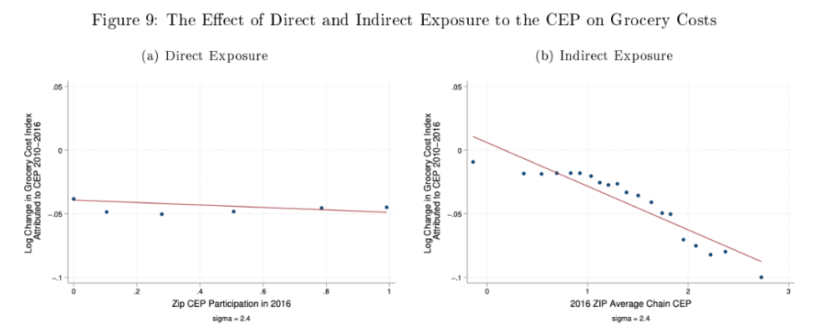As Biden Signs Waiver Extension, Study Shows School Meals Lower Grocery Costs
Research suggests that when the government expands access to free lunch, grocery chains slash prices and families’ food expenses shrink

Get stories like these delivered straight to your inbox. Sign up for The 74 Newsletter
Updated June 27
On June 25, President Biden signed the Keep Kids Fed Act of 2022. The law will extend some school meal waivers through the end of the 2022-23 school year.
With a massive, pandemic-era expansion of free school meals scheduled to expire on June 30, Democrats and Republicans coalesced this week around a possible compromise that would extend the federal program through the summer. Passed by a 376-42 margin in the House of Representatives Thursday, the deal is expected to move through the Senate and be signed by President Biden in the next few days.
Authorized by Congress and the Department of Agriculture over the last two years, the waivers widened the category of students eligible to receive breakfast and lunch. Schools providing meals were also offered higher reimbursement rates for the costs of running their programs, as well as the flexibility to serve food off-site and substitute for items lost to supply-chain snags.Those benefits are often cited by proponents of renewing the waivers, or even making them permanent following the pandemic’s end. But language to continue the program into next year was left out of the FY2023 budget signed by the president in March.
In the near term, the proposed $3 billion Keep Kids Fed Act could ease classroom hunger and simplify the work of schools in the months to come. But research suggests that greater availability of free meals in public schools actually lowers grocery spending even for those without school-aged children. And at a time of sharply rising food prices, it’s conceivable that the end of the waivers would contribute to further inflation.
In a working paper circulated last fall by the National Bureau of Economic Research, academics from the University of Chicago and the Wharton School of the University of Pennsylvania found that an earlier boost to free meals — through the Obama-era Community Eligibility Provision, which allowed certain schools to offer breakfast and lunch to all students without having to process individual applications — caused a significant decline in grocery sales at local retailers. Those chains responded by lowering prices across all their stores, leading nearby households to spend approximately 4.5 percent less in grocery bills in areas where the policy was adopted.
Jessie Handbury, a Wharton economist and one of the paper’s co-authors, called the effects “fairly sizable.”
“Because they’re responding across all their retail locations, the…drop in prices is going to affect all the households in the vicinity of that chain’s stores,” she said. “So you’ll have households that aren’t directly impacted by the demand shock, or that live nowhere near the communities that are taking up universal free lunch, but are still benefiting from it.”
The Community Eligibility Provision was introduced in select states through the Healthy, Hunger-Free Kids Act of 2010, before becoming nationally available in the 2014-15 school year. Participating schools (identified as those where over 40 percent of students qualified for free or reduced-price lunch) could choose to provide such meals to all of their enrolled students, whether they were eligible or not.
To study the effects of the legislation on grocery spending, Handbury and UChicago professor Sarah Moshary gathered information from the National Center for Education Statistics showing school-level participation in the Community Eligibility Provision between the 2011-12 and 2015-16 academic years. They combined that with self-reported grocery purchase figures from the Nielsen Homescan database, which collected data from a representative panel of nearly 50,000 American households over the same timeframe.
Finally, the pair added findings from a separate industry tracker of weekly grocery chain sales and sale quantity by product. In the five years under study, the system included responses from over 20,000 stores.

In all, the study found that homes with school-aged children reduced their grocery spending by an average of 7.5 percent (about $200 annually, or roughly two weeks of spending for families included in the sample) when a local school adopted the Community Eligibility Provision — the direct impact of their children receiving more meals for free in school. What’s more, that drop in sales led grocery chains to slash prices not just for the directly affected stores (i.e., the ones located near CEP schools), but in all of their locations. As a consequence, shopping costs in the median ZIP code affected by the policy were reduced by an average of 4.5 percent.
Handbury said it was plausible that a large number of families who were always eligible to receive free meals at school only began taking advantage of them once the provision was adopted. The sudden universality of the program may have reduced the social penalty sometimes referred to as “lunch shaming,” she surmised.
“You could imagine that when it costs money for their child to get lunch at school, they just automatically pack lunch for their children,” Handbury argued. “And when it became free, that was enough to induce them to at least send their kids to try free school lunch. Possibly because there was a reduction in the stigma associated with getting free lunch — or even getting school lunch — it just became what you did.”
Other studies have also shown clear consumer benefits accruing to families impacted by the program. Another 2021 paper, from researchers at Vanderbilt and the University of Louisville, showed that families with children spent between 5 and 19 percent less on monthly grocery purchases in areas that implemented the Community Eligibility Provision. Low-income households also experienced a meaningful improvement in dietary quality, and fewer were classified as food-insecure, in the wake of CEP adoption.
“The savings of $11 per month (or up to almost $39 for fully exposed ZIP codes) are realistic in magnitude and represent a meaningful change for low-income families that may face especially tight resource constraints,” said Michelle Marcus, one of the paper’s co-authors. “For the average household in our sample with two children, CEP provides about 8.25 additional meals per household for each of the eight academic months.”
Price discounts of that magnitude may not seem like much, but during a period of dramatic inflation — according to the Bureau of Labor Statistics, food prices rose by over 9 percent between April 2021 and April 2022 — they might make a significant difference. Since the COVID-era meal waivers operate essentially like an enhancement of CEP, Handbury noted, their potential expiration could be expected to have “weekly inflationary effects” on those prices.
That’s partly why advocacy groups are already praising the bipartisan deal to extend the waivers for another school year. Earlier this month, the Food Research and Action Center published a white paper touting the effects of the Community Eligibility Provision and advocating further flexibility for provision of school nutrition going forward.
In an email to The 74, a spokesman for FRAC said the group was “excited about the provisions included in the bill that will support access to summer meals, allow children who are eligible for reduced-price meals to receive free meals, and the additional funding for schools and child care.”
Another group, the School Nutrition Association, said in a statement that the deal was a vital resource at a time when the cost of kitchen essentials like wheat bread and dish gloves had risen by well over 100 percent.
“School nutrition professionals have withstood crippling supply chain breakdowns, rising prices and labor shortages in their efforts to provide students healthy meals, at a time when families are struggling with higher costs. With crucial federal waivers on the verge of expiring, this agreement offers school meal programs a lifeline to help build back toward normal operations.”
Get stories like these delivered straight to your inbox. Sign up for The 74 Newsletter


